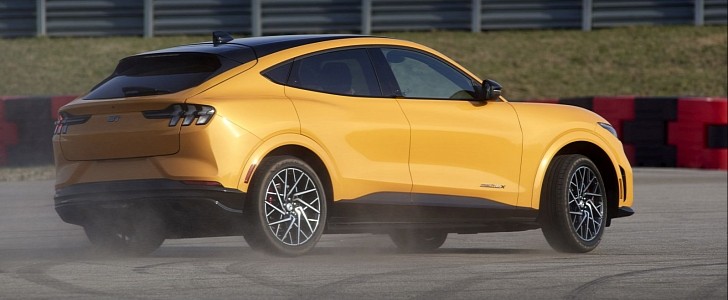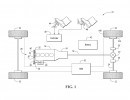Every driver dreams of becoming Ken Block, so drifting is considered the technique to learn if you’re serious about being considered a pilot. Ford let anyone with a driver’s license look like a competent drift pilot with the launch of the Drift Mode in the Focus RS hot-hatch, and is now doubling down with a new patent for a “vehicle with drive mode.”
The patent filed with the U.S. Patent and Trademark Office describes a very interesting technology that could apply to both electric and gas-powered vehicles. Unlike the Focus RS’s Drift Mode, which used torque vectoring and the all-wheel-drive system to spin the rear wheels, the new patent applies to rear-wheel-drive vehicles and relies on braking the rear wheels to initiate the drift.
This is an approach normally used for front-wheel-drive vehicles, which can’t spin the rear wheels. The pilot usually brakes the rear wheels using a hydraulic hand brake system, which causes the car to lose traction and slide. Ford’s patent describes in detail how an automated system should work.
It begins with the driven wheels being decoupled from the engine/motor and the brakes blocking them to induce a slide. The system will then immediately apply power to keep the drift going. The computer will rely on the sensors to figure out the exact torque needed for the slide to continue, without allowing for the car to spin out of control.
“A controller is programmed to, in response to the vehicle being in a drift mode, decouple the driven wheels from the actuator, engage the friction brakes to lockup the driven wheels, and place the actuator in speed control and command a torque to the actuator based on a difference between a measured speed of the actuator and a target speed of the actuator,” reads the patent files with the USPTO.
The new system will work no matter whether the propulsion system uses an electric drive unit or an internal combustion engine, as long as it has a shaft. This is a rather restrictive condition, since most electric vehicles have the electric motors as close to the wheels as possible, but can work on hybrid vehicles. This is convenient as we know all new models Ford has in its pipeline will feature some sort of electrification.
“A vehicle includes an engine having a crankshaft, an electric machine having a shaft, a front-end accessory drive (FEAD) having a tension member operably connecting the crankshaft and the shaft, a drivetrain operably coupling the engine to driven wheels,” is further described the system in the patent filing.
Of course, a patent is no guarantee that Ford will bring this feature to a production vehicle anytime soon. Nevertheless, we expect to see this on the next Ford Mustang, which should come to market quite soon, maybe even this year. Conveniently, the next Mustang will get a hybrid version starting from 2025, according to Automotive News.
This is an approach normally used for front-wheel-drive vehicles, which can’t spin the rear wheels. The pilot usually brakes the rear wheels using a hydraulic hand brake system, which causes the car to lose traction and slide. Ford’s patent describes in detail how an automated system should work.
It begins with the driven wheels being decoupled from the engine/motor and the brakes blocking them to induce a slide. The system will then immediately apply power to keep the drift going. The computer will rely on the sensors to figure out the exact torque needed for the slide to continue, without allowing for the car to spin out of control.
“A controller is programmed to, in response to the vehicle being in a drift mode, decouple the driven wheels from the actuator, engage the friction brakes to lockup the driven wheels, and place the actuator in speed control and command a torque to the actuator based on a difference between a measured speed of the actuator and a target speed of the actuator,” reads the patent files with the USPTO.
The new system will work no matter whether the propulsion system uses an electric drive unit or an internal combustion engine, as long as it has a shaft. This is a rather restrictive condition, since most electric vehicles have the electric motors as close to the wheels as possible, but can work on hybrid vehicles. This is convenient as we know all new models Ford has in its pipeline will feature some sort of electrification.
“A vehicle includes an engine having a crankshaft, an electric machine having a shaft, a front-end accessory drive (FEAD) having a tension member operably connecting the crankshaft and the shaft, a drivetrain operably coupling the engine to driven wheels,” is further described the system in the patent filing.
Of course, a patent is no guarantee that Ford will bring this feature to a production vehicle anytime soon. Nevertheless, we expect to see this on the next Ford Mustang, which should come to market quite soon, maybe even this year. Conveniently, the next Mustang will get a hybrid version starting from 2025, according to Automotive News.






